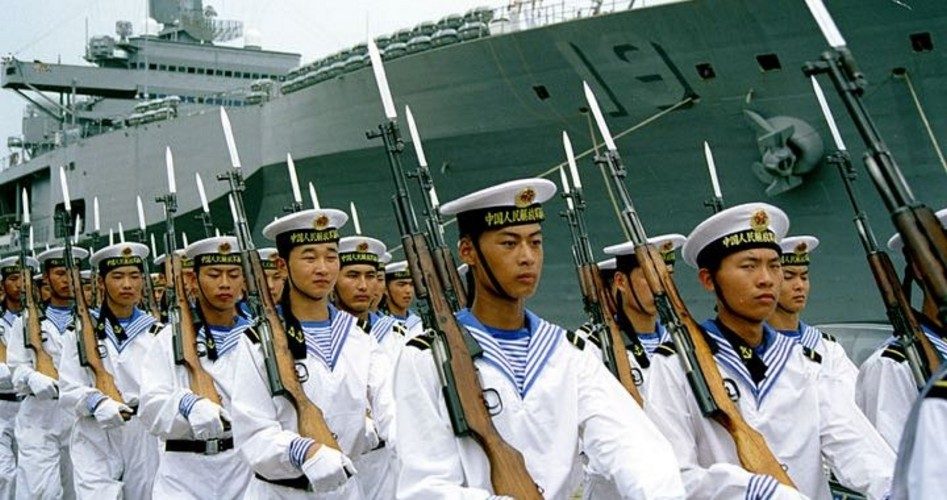
If a movie scene could epitomize the situation between the United States and China, it might be the introduction of villainous boxer Clubber Lang in Rocky III. Lang is seen training hard, playing for keeps in the ring, and putting his nose to the grindstone, driven by burning ambition. Scenes of world champ Rocky Balboa are interposed, showing him slacking off, distracted by fun and frivolity, oblivious to the burgeoning threat that could knock him into oblivion.
No, China isn’t ready to club us into unconsciousness just yet, but it, well, does have the eye of the dragon. In fact, addressing a rapid naval build-up that threatens to oust the United States from the Pacific, a top American admiral wrote earlier this year that there “is no guarantee that the United States would win a future conflict with China.”
And China’s military rise is striking. The nation just launched its first domestically built aircraft carrier, giving it two now, with a third under construction. Analysts cited by the New York Times say the nation will ultimately construct five or six.
Overall, China already has a larger naval force than does the United States, with “317 warships and submarines in active service, compared with 283 in the U.S. Navy,” reports the Times. The paper further informs, “The Chinese navy — officially the People’s Liberation Army Navy — has built more than 100 warships and submarines in the last decade alone, more than the entire naval fleets of all but a handful of nations.… In 1995, China had only three submarines. It now has nearly 60 and plans to expand to nearly 80.”
And while our fleet is still superior qualitatively, this could change, especially since China has long been stealing our military technology. As to these technological leaps, the Times tells us, “Last year, China also introduced the first of a new class of heavy cruisers — or ‘super destroyers’ — that, according to the U.S. Office of Naval Intelligence, ‘are comparable in many respects to most modern Western warships.’ Two more were launched from dry dock in Dalian in July, the state media reported.”
In fact, Admiral Philip Davidson, the new commander of the U.S. Indo-Pacific Command, expressed in March that “China is now capable of controlling the South China Sea in all scenarios short of war with the United States,” reports the Times.
Moreover, “He described China as a ‘peer competitor’ gaining on the United States not by matching its forces weapon by weapon but by building critical ‘asymmetrical capabilities,’ including with anti-ship missiles and in submarine warfare. ‘There is no guarantee that the United States would win a future conflict with China,’ he concluded,” the Times continued.
Most troubling is the following, also courtesy of the Times:
A centerpiece of this [asymmetrical] strategy is an arsenal of high-speed ballistic missiles designed to strike moving ships. The latest versions, the DF-21D and, since 2016, the DF-26, are popularly known as “carrier killers,” since they can threaten the most powerful vessels in the U.S. fleet long before they get close to China. The DF-26, which made its debut in a military parade in Beijing in 2015 and was tested in the Bohai Sea last year, has a range that would allow it to menace ships and bases as far away as Guam, according to the latest Pentagon report on the Chinese military, released this month. These missiles are almost impossible to detect and intercept, and are directed at moving targets by an increasingly sophisticated Chinese network of radar and satellites.
… Such missiles pose a particular challenge to U.S. commanders because neutralizing them might require an attack deep inside Chinese territory, which would be a major escalation.
Of course, China can’t yet defeat the United States in an all-out global war. But it has possibly reached a point where it can defend its interests in the South China Sea, as intervention there may now (or soon) be too costly for the United States to contemplate.
Reflecting China’s grand ambitions, these “interests” include artificial islands constructed to enable the nation to lay claim to international waters — yet this isn’t the only way it projects power beyond its borders. There’s also the soft power of Chinese infiltration of our schools, influence over entertainment, and buying of influence, part of which I wrote about on Monday.
To truly understand the picture this paints, to grasp the threat posed by China, we must consider the culture’s mentality (know thy enemy). The Chinese are very prideful; “losing face” is a serious matter to them. And they believe that such humiliation is precisely what they’ve endured due to domination by the Western powers and Japan. China has a chip on its shoulder the size of, well, China — and the nation wants a measure of vengeance.
This is exacerbated by another aspect of the Chinese mentality, one now foreign to us. Western pseudo-elites have been overcome by the tabula rasa theory of man, cultural relativism, and, related to this, internationalism. In this way of thinking, since all people are basically the same, borders aren’t an expression of the principle “good fences make good neighbors” but are artificial barriers serving as an impediment to our becoming a one-world community. We’re all just citizens of the Earth, you see.
The Chinese mentality reflects man’s historical default. They view their culture and race as superior and, many suspect, believe this grants them the right to dominate the world. They view our primacy as a quirk of history attributable only to our mastery of the arts of war, and this sticks in their craw. What they view as the natural order must be reestablished.
To understand an advantage associated with this, consider why China, one of the world’s oldest civilizations, is still around while the Roman Empire disappeared. The latter at its height was unrivaled in power, but it was a conglomeration of disparate peoples — a multicultural entity — bound together by nothing but Rome’s power. When that power diminished the empire dissolved.
In contrast, while China has seen difficult times and disaster, governments come and go, three things have remained throughout: the Chinese people, culture, and language. China is a true nation, meaning an extension of the tribe, which itself is an extension of the family.
This brings us to us. Are we becoming more like a nation, one people unified? Or are we become more like the Roman Empire, Balkanized and bound together only by law and might?
Not only are we fracturing ourselves demographically and culturally via unwise immigration policies, we’re also fracturing ideologically (and exhibiting immaturity). China is trying to figure out how to dominate the world; we are trying to figure out how many “genders” there are. We’re busy conjuring up new “rights” for an alphabet soup of “identities”; China supposes might makes right. We’re eating ourselves alive and de-westernizing the West with multiculturalism; China is enforcing one culture and seeks to spread it the world over. Put simply, we’re busy fighting ourselves — China’s preparing to fight us.
The prospect of China as global hegemon should give the United States, and the world, pause. The nation plans to have 600 million surveillance cameras in place by 2020 to monitor its people Big Brother-style. It uses the information collected to, as the government puts it, “purify” society: that is, to determine how much each citizen conforms to state ideology and then assign rights, privileges, and punishments accordingly (consequently, some Chinese aren’t permitted to fly, board trains, get loans, or send their children to private school). Clearly, Beijing thinks Orwell’s 1984 is a how-to manual.
Now, do you want to bet your children’s future that China wouldn’t impose this on the whole world if it could?
The Rocky character’s problem in Rocky III was that he’d lost his fire; his mentality was all wrong. China right now has the eye of the dragon. If we don’t get our eye back on what really matters, our loss of the world title may not only involve a knockout — it may be permanent.
Photo: U.S. Navy


